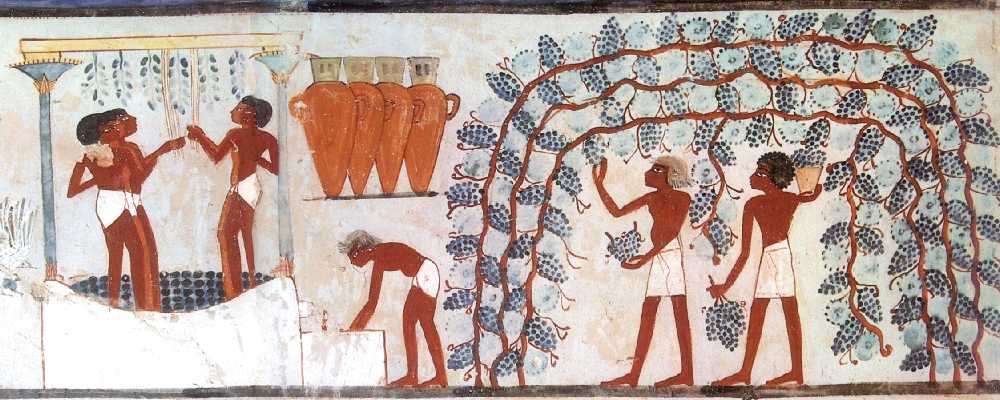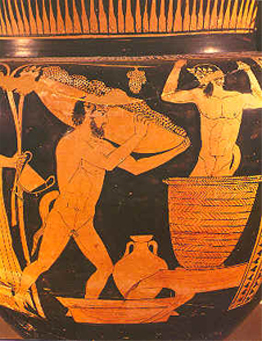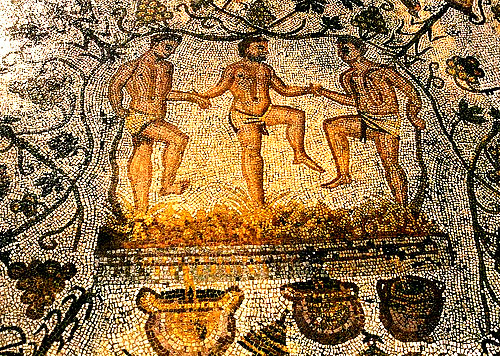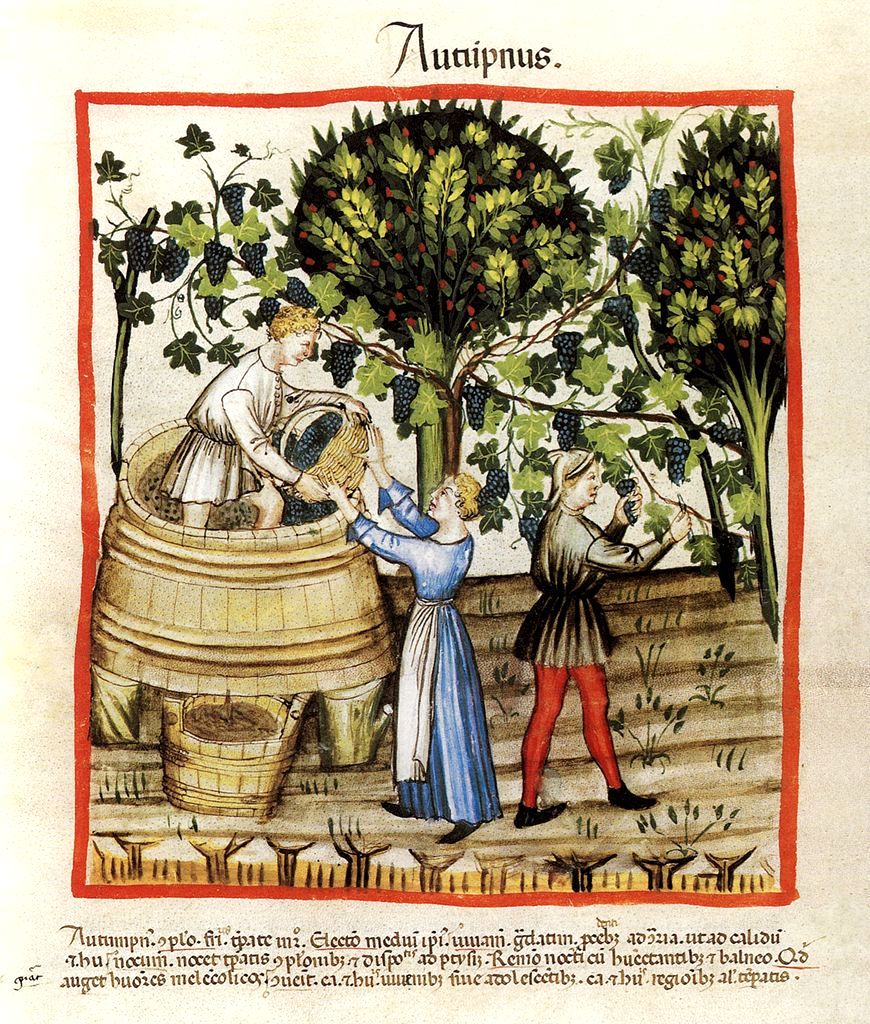- 5400 BC
- On the Zagros mountains of Iran were found jars to store wine dating back to Neolithic Age, around 5400 BC
- 4100 BC
- Archaeologists discovered the oldest winery ever found in Armenia, dating back to around 4100 BC
- 3100 BC
- Wine was produced in ancient Egypt. It was also used in ceremonies by Pharaohs and priests in ceremonies, due to its resemblance with blood. 700 jars containing around 4500 liters of wine were found in Scorpion I tomb, dating back to around 3100 BC.

Fig. 1: grape harvest and wine making in ancient Egypt - 1200 BC
- The Phoenicians, while colonizing and trading through the mediterranean sea, begun to spread wine and wine grapes in North Africa, Greece and Italy
- 800 BC
- With the fall of the Mycenean culture (the reference period of the eroic ages of the War of Troy and of Ulysses travels) and the raising of the Classic Greece age, the techniques of wine making were improved and wine had a major importance in Greek culture, to the point that Dynisus, one of the most important Gods, was dedicated to them.

Fig. 2: grape harvest and wine making in ancient Greece - 200 BC
- The Senatorial Republic of Rome begun to expand in the Mediterranean Sea, conquering part of the North Africa and Spain, in 146 BC Greece is conquered. In 50 BC, Julius Caesar conquered the current France.
On 27 BC Rome turned into the Roman Empire, with Augustus its first emperor; after that, it peaked its maximum expansion in 116 AD, when the Roman Empire spans over the whole North Africa, Spain, France, East Europe, the whole Middle East up to Armenia and Iran.
Wine had a central importance in Roman culture, the god Dyonisus was adopetd with the name of Bacchus. The techniques were greatly improved and it was exactly in this period that Gographical Origin and the vintages were officially recognized.
With Roman Empire, wine was widely used and it was symbol of culture and refinement, while beer was considered the unrefined drink of the barbarians from France and Germany. That’s why, in all the conquered Provinces, Rome exported not only wine, but also wine grapes, in order to develope wine industry all over the Empire.
It's thanks to the Roman Empire that wine reached the cultural importance and it has in the Modern and Contemporary Era.
Fig. 3: grape harvest and wine making in ancient Roman Empire - 119 BC
- The "Vitis Vinifera", the main wine grape variety for wine, was introduced in China through the Central Asia since the third Century BC. The Records of the Grand Historian, finished in 94 BC by the Han dynasty official Sima Qian, reports that diplomat and traveller Zhang Qian reported about populations of Central Asia that were making wine from grapes, it is possible that Xhang Qian brang grapes with him on his second journey on 119 BC.
- 476
- After the death of Emperor Theodosius I in 395, the Roman Empire was split in two: the Western Roman Empire, which capital was Rome, and the Eastern Roman Empire, which capital was Byzantium, the current Istanbul. After the fall of the Western Roman Empire in 476 and the progressive Muslim invasion of North Africa since around 643, production of wine decreased considerably; nonetheless, also due to the strong connection with the Catholic rites, the monks of the monasteries of Italy and France focused on cultivation of grapes and production of wine, furtherly perfectioning the techniques.
- 618
- During the Tang Dysnasty, grape wine is spread not only among Chinese nobles, but also among the population, as celebrated in the poems of poet Li Bai.
- 1200
- On the late Middle Ages and the early Renaissance, wine regained its importance in Europe, as well as distilled spirits begun to be popular.
The Silk Road was open for trades, connecting Europe to China. The Venetian merchant traveller Marco Polo went to China, where served under Kublai Khan, founder of the Yuan dinasty, under which wine industry and culture were promoted, but due to the evergrowing popularity of the Baijiu, issue in territorial control and influence of muslim in western regions, wine industry was never flourishing.
Fig. 4: grape harvest and wine making in Middle Ages - 1492
- After the european Discovery of the Americas, wine followed the spanish conquerors to the Colonies of South and Central America.
- 1549
- In the 16th Century, the Portuguese Empire established colonies in China (Macao) and Japan.
In 1549 the missionary Francis Xavier arrived in Japan bringing wine and other precious goods, such as clocks, music boxes, mirrors, crystals and cloths, as a gift for the Daimyō (feudal lords) he met.
In 1582, the italian priest Matteo Ricci arrived in Macau. Named Lì Mǎdòu in China, his work has been major bridge between European and Chinese culture, due to his translation in Chinese of notions of mathematics and astronomy, his essays and his map of the World annoted in Chinese. - 1619
- Grape growing in North America began in 1619 with the Twelfth Act, a mandate by the House of Burgesses, the first legislative assembly in the American colonies.
- 1659
- With the Dutch colonization of South Africa, the demand of wine of the colonists pushed the farmers to begin wine production, in 1659 the first wine made from French Muscadel grapes were successfully made.
- 1788
- Captain Arthur Phillip and the First Fleet arrived in Australia in 1788 with the task to settle the first British Colony. The colonists brang wine and vine cuttings from South Africa. Between 1800 and 1820, the first commercial winery was well established.
- 1992
- After the economic reform, China’s Economy begin to boost.
- 2013
- Chinese Middle-class begins to appreciate wine not as a mere status symbol of luxury, but for its taste, the pleasure and experience it offers and as a status symbol of well being and culture. In 2014 China becomes the first World Market for red wine.
- 2015
- In 2015 and in 2016 Italy is the first World producer of Wine, with its wide varieties, history and top-notch respect for both the millennial traditions and innovation.